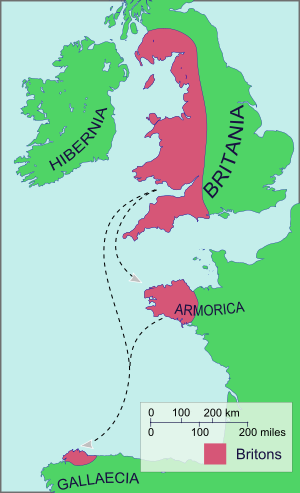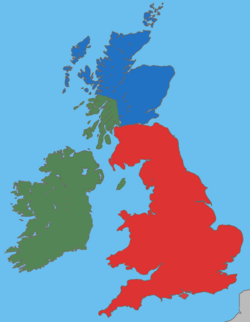Brittonic languages facts for kids
Quick facts for kids Brittonic |
|
|---|---|
| *Brittonikā, Brythonic, British Celtic | |
| Geographic distribution: |
Wales, Cornwall, Brittany, historically in Cumbria plus other areas in the west of England, Strathclyde, Pictland, Galicia |
| Linguistic classification: | Indo-European
|
| Proto-language: | Common Brittonic |
| Subdivisions: |
Pictish †
|
 The Brittonic-speaking community around the sixth century
|
|
The Brittonic languages (also called Brythonic or British Celtic) are a family of languages. They are one of two main groups of Insular Celtic languages, which are Celtic languages spoken on islands. The other group is called Goidelic.
Today, the Brittonic family includes three living languages: Breton, Cornish, and Welsh. The name Brythonic was created by a Welsh expert named John Rhys. He used the Welsh word Brython, which means "Ancient Britons." This helped tell them apart from Anglo-Saxons or Gaels.
These languages all came from an older language called Common Brittonic. This language was spoken across Great Britain during the Iron Age and when the Romans ruled Britain. Around the 5th and 6th centuries, some Britons moved to Europe. They took their Brittonic language with them, especially to Brittany in France.
Over the next few hundred years, Common Brittonic started to split into different dialects. These dialects eventually became Welsh, Cornish, Breton, Cumbric, and probably Pictish. Welsh and Breton are still spoken by many people today. Cornish almost died out, but a movement to bring it back has led to more people learning and speaking it. Sadly, Cumbric and Pictish are now extinct. They were replaced by Goidelic languages and English.
Some places like the Isle of Man and Orkney might have once spoken Brittonic languages too. However, Manx (a Goidelic language) took over on the Isle of Man, and Norse (a Germanic language) took over on Orkney. There's also a group of Brittonic speakers in Patagonia, South America. This is because of a Welsh settlement there called Y Wladfa.
Contents
What are the Brittonic Languages Called?
The names "Brittonic" and "Brythonic" are terms used by experts. They help us talk about the Celtic languages of Britain and the older language they came from, Common Brittonic. These names help avoid confusion with other terms like "British" or "Cymric."
The name "Brythonic" was made up in 1879 by a Celtic expert named John Rhys. He got it from the Welsh word Brython. The name "Brittonic" came a bit later in the 19th century. It comes from the word "Briton."
"Brittonic" became more popular in the 20th century. A very important book by Kenneth H. Jackson in 1953, Language and History in Early Britain, used it. Jackson noted that "Brythonic" was starting to sound old-fashioned. Today, "Brittonic" is often used instead.
The name "Britain" itself comes from the Latin word Latin: Britannia. This word likely came from an even older native word for the island, *Pritanī. Some ancient Greek writers mentioned the British Isles. They used words like πρεττανική (Prettanikē), meaning "The Britannic land." The word *Pretani might have meant "the painted ones" or "the tattooed folk." This could refer to how ancient people decorated their bodies.
How Do We Know About Brittonic Languages?
We learn about early Brittonic languages from different sources.
- We look at old coins and inscriptions (words carved into stone or metal).
- We read what ancient writers said about the people and their languages.
- We study old place names and personal names that were written down.
For the languages spoken more recently, we have writings from the Middle Ages. We also have information from people who speak these languages today. Place names continue to be a valuable source of information.
Key Features of Brittonic Languages
The Brittonic languages are sometimes called P-Celtic languages. This is because a certain sound in the older Proto-Celtic language changed to a 'p' sound in Brittonic. In contrast, the Goidelic languages kept a 'k' sound.
Here are some other important features:
- Starting Sounds:
- A 'w' sound at the beginning of a word in Proto-Celtic became 'gw-' in Brittonic languages. For example, the old word for 'white' became Welsh gwyn and Breton gwenn. In Irish, it became fionn.
- An 's-' sound at the start of a word often changed to 'h-'. For example, the old word for 'long' became Welsh hir and Breton hir. In Irish, it stayed síor.
- Sound Changes in the Middle of Words: Sounds in the middle of words also changed over time. For example, some 't' sounds became 'd' sounds.
Family Tree of Brittonic Languages
The Brittonic languages have a clear family tree, showing how they developed:
- Common Brittonic is the ancestor of:
- Western Brittonic languages, which led to:
- Southwestern Brittonic languages, which led to:
| Common Brittonic | |||
| Western Brittonic | Southwestern Brittonic | ||
| Cumbric | Welsh | Cornish | Breton |
Today, Welsh, Cornish, and Breton are the Brittonic languages still in use. Welsh and Breton have been spoken continuously for a very long time. Cornish almost disappeared in the 18th or 19th century. However, a movement to bring it back has created a small but growing number of new speakers.
The extinct language Cumbric is also notable. Pictish is another extinct language that might have been Brittonic. Some people once thought Pictish was not an Indo-European language, but most language experts today do not agree with that idea.
History and Where They Came From

The modern Brittonic languages all came from an older language called Common Brittonic. Experts believe this language developed from an even older language called Proto-Celtic by about 600 BC.
A big study of ancient DNA showed that people migrated into southern Britain during the middle to late Bronze Age (1300–800 BC). These new people were genetically similar to ancient people from Gaul (modern France). Their genes quickly spread through southern Britain. This suggests they might have brought early Celtic languages to Britain.
There was less migration during the Iron Age. So, it's likely that Celtic languages arrived in Britain before then. Some experts think a Goidelic branch of Celtic might have been spoken in Britain first. But this Bronze Age migration would have introduced the Brittonic branch.
Brittonic languages were probably spoken across most of Great Britain before the Romans invaded. The Isle of Man later adopted a Goidelic language, Manx. When the Romans ruled parts of Britain (from AD 43 to about 410), Common Brittonic borrowed many Latin words. These words were for new ideas like cities and new ways of fighting. They also borrowed everyday words that replaced native ones. For example, the word for "fish" in all modern Brittonic languages comes from the Latin word piscis. About 800 Latin words are still found in the three modern Brittonic languages. Pictish might have borrowed fewer Latin words than other Brittonic languages.
After the Romans left, around AD 410, Common Brittonic started to split into at least two main dialects. These were Southwestern Brittonic and Western Brittonic. Other dialects might have existed too, like Eastern Brittonic, but we have little evidence of them. Between the end of Roman rule and the mid-6th century, these two dialects became clearly separate. Western Brittonic developed into Cumbric and Welsh. Southwestern Brittonic developed into Cornish and Breton. Breton was carried to continental Europe when Britons moved to Armorica (modern Brittany).
By AD 600, Common Brittonic had fully split into these different languages. Many Britons stayed in areas that were taken over by the Anglo-Saxons. However, over the 5th and 6th centuries, most of them started speaking the English language.
Decline of Brittonic Languages
The Brittonic languages spoken in what is now Scotland, the Isle of Man, and much of England began to disappear in the 5th century. This happened as Irish-speaking Gaels and Germanic peoples settled in these areas. By about 1129, a writer named Henry of Huntingdon said that Pictish was "no longer spoken."
The Brittonic languages had mostly disappeared from Britain by the 11th century. The only exceptions were Cornwall, Wales, and some English counties bordering them, like Devon. Welsh continued to be spoken in parts of western Herefordshire until the late 1800s. Even today, a few small areas in Shropshire still have Welsh speakers.
Brittonic Traces in England, Scotland, and Ireland
Place Names and River Names
One of the biggest ways Brittonic languages left their mark is in place names and hydronyms (river names). Many place names in lowland Scotland and parts of England come from Brittonic words. Brittonic names are less common in most of England, except for old Roman-British towns.
Some famous names that come from Brittonic include London, York, Dover, and Colchester. You can also find Brittonic elements in English place names. For example, bre- and bal- often mean "hills." Words like combe (or coomb(e)) for a small valley and tor for a hill were borrowed directly into English from Brittonic.
Other names show where Britons used to live. For example, Dumbarton comes from the Scottish Gaelic Dùn Breatainn, meaning "Fort of the Britons." Walton means a settlement where the Wealh (Britons) still lived.
The number of Celtic river names in England increases as you go from east to west. Examples include Avon, Chew, Frome, Axe, Brue, and Exe. River names with parts like "der-/dar-/dur-" and "-went" are also common. These include "Derwent," "Darent," and "Dour."
Brittonic Influence on English
Some people, like J. R. R. Tolkien, have suggested that Celtic languages influenced English. However, most experts agree that Brittonic had only a small impact on English words. Aside from place names, only a few everyday words might come from Brittonic. These include bin, brock (a badger), crag, and tor.
Another possible legacy is the sheep-counting system called Yan tan tethera in northern England. This system is found in areas that were traditionally Celtic, like Cumbria. Also, some words used in Cornish mining are still used in English mining terms, such as costean and vug.
Those who disagree with a strong Brittonic influence on English point out that many place names don't keep their original Brittonic meaning. For example, Avon comes from the Celtic word for river, abona (or Welsh afon). But the English used it as a specific name, not just a general word for "river." The River Ouse, Yorkshire contains the word usa, which simply means 'water'. The name of the river Trent comes from the Welsh word for a trespasser, meaning an "over-flowing river."
Some researchers have argued that the way English uses helping verbs like do and be (as in "I am loving") might come from Brittonic influence. However, others think these forms developed naturally within English. This is because many of these forms only appeared later in the Middle English period.
Brittonic Influence on Goidelic Languages
Brittonic languages had a more noticeable, though less known, influence on Scottish Gaelic. Scottish and Irish Gaelic have many ways of using prepositions with verbs. This suggests that these ways come from their shared Celtic heritage.
Scottish Gaelic has some words borrowed from P-Celtic languages. Since there's a lot of shared Celtic vocabulary, it's not always easy to tell P-Celtic and Q-Celtic words apart. However, some common words like monadh (meaning 'mountain') are clearly related to Welsh mynydd.
The Brittonic influence on Scottish Gaelic is often seen by comparing it to Irish language usage. Irish was less likely to be influenced by Brittonic. For example, the word srath (anglicized as "Strath") is a native Goidelic word. But its meaning seems to have been changed by the Brittonic word ystrad, which has a slightly different meaning. Brittonic also influenced Irish by lending many Latin-derived words. This happened when Christianity spread to Ireland from Britain.
See also
 In Spanish: Lenguas britónicas para niños
In Spanish: Lenguas britónicas para niños

